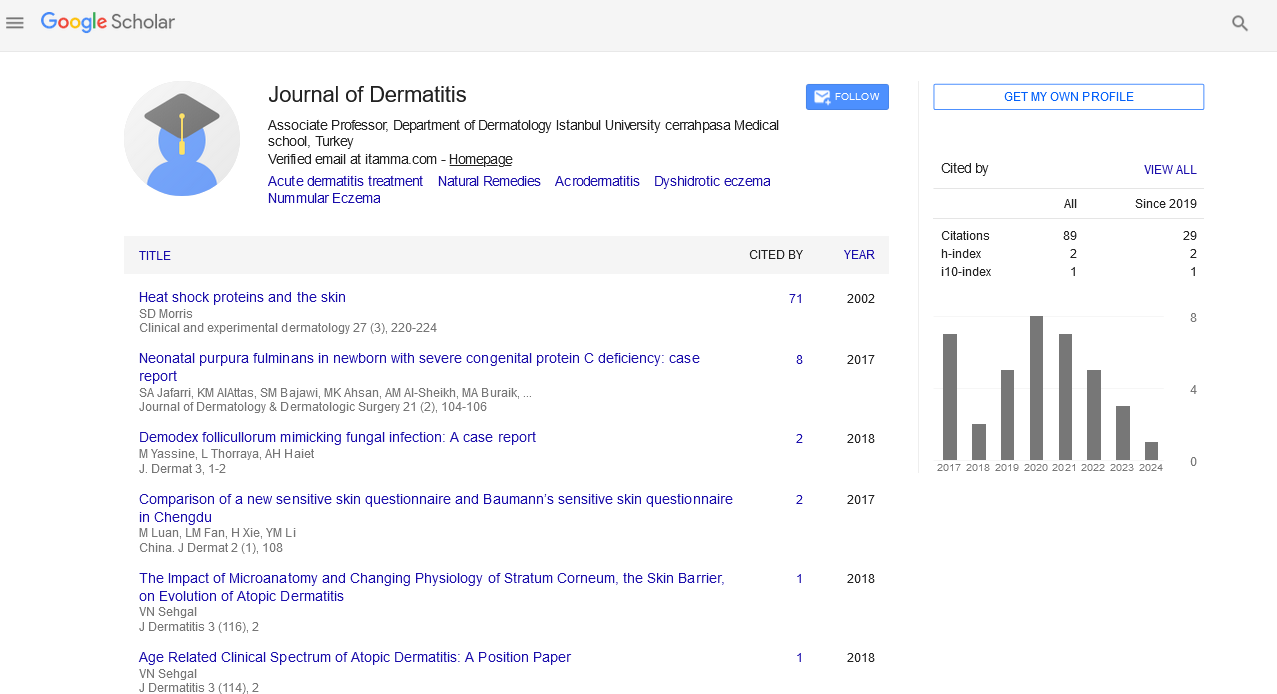Indexed In
- RefSeek
- Hamdard University
- EBSCO A-Z
- Euro Pub
- Google Scholar
Useful Links
Share This Page
Journal Flyer

Open Access Journals
- Agri and Aquaculture
- Biochemistry
- Bioinformatics & Systems Biology
- Business & Management
- Chemistry
- Clinical Sciences
- Engineering
- Food & Nutrition
- General Science
- Genetics & Molecular Biology
- Immunology & Microbiology
- Medical Sciences
- Neuroscience & Psychology
- Nursing & Health Care
- Pharmaceutical Sciences
Short Communication - (2023) Volume 8, Issue 3
Gabapentin as a Potential Treatment for Mice with Ulcerative Dermatitis
Darwin Evan*Received: 29-Mar-2023, Manuscript No. JOD-23-20854; Editor assigned: 31-Mar-2023, Pre QC No. JOD-23-20854 (PQ); Reviewed: 21-Apr-2023, QC No. JOD-23-20854; Revised: 28-Apr-2023, Manuscript No. JOD-23-20854 (R); Published: 05-May-2023, DOI: 10.35248/2684-1436.23.8.192
Description
Ulcerative dermatitis is a common and often debilitating condition in laboratory mice. The condition is characterized by lesions and inflammation on the skin, which can lead to itching, discomfort, and pain. In severe cases, ulcerative dermatitis can lead to infection and even death. Gabapentin is a medication that has been used to treat neuropathic pain and seizures in humans, and there is growing evidence that it may also be effective in treating ulcerative dermatitis in mice. This article will review the available literature on the use of gabapentin to treat ulcerative dermatitis in mice [1,2].
Ulcerative dermatitis is a complex condition that can be caused by a variety of factors, including genetics, environmental factors, and behavioral issues. The condition is commonly seen in laboratory mice, where it can be exacerbated by overcrowding, poor hygiene, and other stressors. The lesions associated with ulcerative dermatitis typically begin as small scabs or bumps on the skin and can progress to open wounds or ulcers that are prone to infection. The condition is often difficult to treat, and current treatment options are limited. Gabapentin is a medication that was originally developed to treat epilepsy, but it has since been found to be effective in treating a variety of other conditions, including neuropathic pain, anxiety, and restless leg syndrome [3-5].
The medication works by binding to a specific type of calcium channel in the nervous system, which can help to reduce the activity of overactive neurons. This can be particularly helpful in treating conditions where the nervous system is overstimulated, such as in neuropathic pain or epilepsy. Recent studies have suggested that gabapentin may also be effective in treating ulcerative dermatitis in mice. In a study published in the journal Laboratory Animals, researchers investigated the use of gabapentin to treat ulcerative dermatitis in a group of laboratory mice. The mice were divided into two groups, with one group receiving gabapentin and the other group receiving a placebo. The researchers found that the mice who received gabapentin had a significant reduction in the severity of their ulcerative dermatitis lesions compared to the mice who received the placebo [6-8].
Investigated the use of gabapentin to treat ulcerative dermatitis in a group of mice that were genetically predisposed to the condition. The researchers found that the mice who received gabapentin had a significant reduction in the severity of their ulcerative dermatitis lesions compared to the mice who received a placebo. In addition, the researchers found that the mice who received gabapentin had a reduction in the number of inflammatory cells in their skin, suggesting that the medication may help to reduce inflammation associated with the condition. While these studies suggest that gabapentin may be effective in treating ulcerative dermatitis in mice, more research is needed to confirm these findings and to determine the optimal dosage and treatment duration. In addition, it is important to note that gabapentin may have side effects in mice, as it does in humans. Common side effects of gabapentin in mice can include sedation, ataxia, and decreased appetite. Therefore, it is important to carefully monitor mice that are being treated with gabapentin to ensure that they are not experiencing any adverse effects [9].
In conclusion, ulcerative dermatitis is a common and often debilitating condition in laboratory mice, and current treatment options are limited. Gabapentin is a medication that has been found to be effective in treating a variety of conditions, including neuropathic pain and seizures, and recent studies suggest that it may also be effective in treating ulcerative dermatitis in mice. While more research is needed to confirm these findings and to determine the optimal dosage and treatment duration, gabapentin may offer a promising new treatment option for this challenging condition [10-13].
References
- De Vries HJ, Schallig HD. Cutaneous Leishmaniasis: A 2022 Updated Narrative Review into Diagnosis and Management Developments. Am J Clin Dermatol. 2022;23(6):823-840.
[Crossref] [Google Scholar] [PubMed]
- Weina PJ, Neafie RC, Wortmann G, Polhemus M, Aronson NE, Strausbaugh LJ. Old world leishmaniasis: an emerging infection among deployed US military and civilian workers. Clin Infect Dis. 2004;39(11):1674-1680.
[Crossref] [Google Scholar] [PubMed]
- Aronson N, Herwaldt BL, Libman M, Pearson R, Lopez-Velez R, Weina P, et al. Diagnosis and treatment of leishmaniasis: clinical practice guidelines by the Infectious Diseases Society of America (IDSA) and the American Society of Tropical Medicine and Hygiene (ASTMH). Clin Infect Dis. 2016;63(12):202-264.
[Crossref] [Google Scholar] [PubMed]
- Murray HW. Leishmaniasis in the United States: treatment in 2012. Am J Trop Med. 2012;86(3):434.
[Crossref] [Google Scholar] [PubMed]
- Ramalho DB, Silva RE, Senna MC, Moreira HS, Pedras MJ, Avelar DM, et al. Meglumine antimoniate intralesional infiltration for localised cutaneous leishmaniasis: a single arm, open label, phase II clinical trial. Mem Inst Oswaldo Cruz. 2018;113.
[Crossref] [Google Scholar] [PubMed]
- Brito NC, Rabello A, Cota GF. Efficacy of pentavalent antimoniate intralesional infiltration therapy for cutaneous leishmaniasis: A systematic review. PloS one. 2017;12(9):e0184777.
[Crossref] [Google Scholar] [PubMed]
- Arboleda M, Barrantes S, Usuga L, Robledo S. Successful treatment of cutaneous leishmaniasis with intralesional meglumine antimoniate: A case series. Rev Soc Bras Med Trop. 2019;52;e.20180211.
- Calvopiña M, Cevallos W, Paredes Y, Puebla E, Flores J, Loor R, et al. Intralesional infiltration with meglumine antimoniate for the treatment of leishmaniasis recidiva cutis in Ecuador. Am J Trop Med. 2017;97(5):1508.
[Crossref] [Google Scholar] [PubMed]
- Cabanillas B, Novak N. Atopic dermatitis and filaggrin. Curr Opin Immunol. 2016;42:1-8.
[Crossref] [Google Scholar] [PubMed]
- De Benedetto A, Rafaels NM, McGirt LY, Ivanov AI, Georas SN, Cheadle C, et al. Tight junction defects in patients with atopic dermatitis. J Allergy Clin Immunol. 2011;127(3):773-786.
[Crossref] [Google Scholar] [PubMed]
- Katoh N, Ohya Y, Ikeda M, Ebihara T, Katayama I, Saeki H, et al. Japanese guidelines for atopic dermatitis 2020. Allergol Int. 2020;69(3):356-369.
[Crossref] [Google Scholar] [PubMed]
- Schempp CM, Windeck T, Hezel S, Simon JC. Topical treatment of atopic dermatitis with St. John's wort cream–a randomized, placebo controlled, double blind half-side comparison. Phytomedicine. 2003;10:31-7.
[Crossref] [Google Scholar] [PubMed]
- Ellison JA, Patel L, Ray DW, David PT, Clayton PE. Hypothalamic-pituitary-adrenal function and glucocorticoid sensitivity in atopic dermatitis. Pediatrics. 2000;105(4):794-799.
[Crossref] [Google Scholar] [PubMed]
Citation: Evan D (2023) Gabapentin as a Potential Treatment for Mice with Ulcerative Dermatitis. J Dermatitis. 8:192.
Copyright: © 2023 Evan D. This is an open-access article distributed under the terms of the Creative Commons Attribution License, which permits unrestricted use, distribution, and reproduction in any medium, provided the original author and source are credited.

